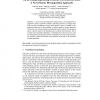Free Online Productivity Tools
i2Speak
i2Symbol
i2OCR
iTex2Img
iWeb2Print
iWeb2Shot
i2Type
iPdf2Split
iPdf2Merge
i2Bopomofo
i2Arabic
i2Style
i2Image
i2PDF
iLatex2Rtf
Sci2ools
266
click to vote
ICA
2012
Springer
2012
Springer
On Revealing Replicating Structures in Multiway Data: A Novel Tensor Decomposition Approach
A novel tensor decomposition called pattern or P-decomposition is proposed to make it possible to identify replicating structures in complex data, such as textures and patterns in music spectrograms. In order to establish a computational framework for this paradigm, we adopt a multiway (tensor) approach. To this end, a novel tensor product is introduced, and the analysis of its properties shows a perfect match to the identification of recurrent data structures. Out of a whole class of possible algorithms, we illuminate those derived so as to cater for orthogonal and nonnegative patterns. Simulations on texture images and music sequence confirm the benefits of the proposed model and of the associated learning algorithms. Key words: tensor decomposition, tensor product, pattern analysis, nonnegativematrix decomposition, structural complexity 1 Problem Formulation Estimation problems for data with self-replicating structures, such as images, various textures and music spectrograms requ...
Related Content
| Added | 24 Apr 2012 |
| Updated | 24 Apr 2012 |
| Type | Journal |
| Year | 2012 |
| Where | ICA |
| Authors | Anh Huy Phan, Andrzej Cichocki, Petr Tichavský, Danilo P. Mandic, Kiyotoshi Matsuoka |
Comments (0)

